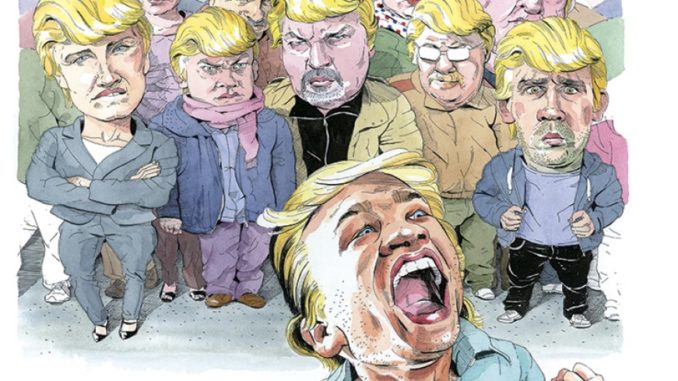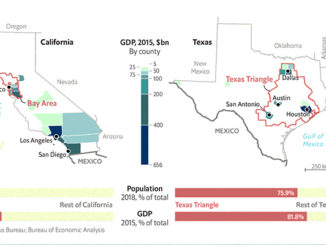
by Alex Gonzalez
The angriest and most pessimistic people in America that pundits and polls/surveys call “white blue-collar” Americans are the most “angry; they are also a political movement made up of tea party groups who claim to be very angry and want to veer the Republican Party into a more “conservative” party. These white blue-collar Americans and tea party groups are lured to Donald Trump because he attacks trade deals, America’s surging trade deficits, and the loss of manufacturing jobs in the U.S.; they claim that Trump is right and that we should build a fence to secure the border with Mexico, and end trade deals like NAFTA. But these claims by both the “blue-collar whites” and tea party groups, who are Donald Trump and Ted Cruz supporters, are political fabrications perpetrated by upper-income affluent social conservatives and “conservative” media groups who benefits from political chaos withing the Republican Party; and they have a plan to sabotage the Republican Party to keep power.
These so-called “white blue-collars” and tea party groups express heavy mistrust of every institution in American society: not only government, but corporations, unions, even the political party they typically vote for—the Republican Party of Romney, Ryan, and McConnell, which they despise as a sad crew of weaklings and sellouts. They claim to be pissed off at the party because they never delivered on their promises of repealing Obamacare, and “securing the border.” They also claim economic anxiety because they feel they can’t find good paying jobs, or that immigrants are taking the jobs that should be going to Americans. They also feel that the nation is changing so much demographically and economically that they resent the changes and claim we are losing our core culture, and therefore, they engage in cultural grievances. So when Donald Trump came along, they were the people who told the pollsters, “That’s my guy.”
These populists white blue-collars and tea partiers seeking to defend —health care, pensions, and other programs that benefit older people and jobs taken by foreigners —against bankers and technocrats who endlessly demand austerity; against migrants who make new claims and challenge accustomed ways; against a globalized market that depresses wages and benefits.
However, the radicalized cultural plight and economic demands by these white blue-collars and tea party interest groups have nothing to with conservatism, job security or lost of American culture, but rather with a false narrative created by those who benefit from such cultural resentment – talk radio and populist leaders like Trump and Ted Cruz and others who see upending the party structure as the only way to move up in the ranks. So this economic distress is in fact only a pretext by those leading this narrative to continue the economic and power grab (status-quo) and exclude new blood from political power and government programs.
The “Great Recession” ended in the summer of 2009. Since then, the U.S. economy has been growing, but most incomes have not grown comparably. In 2014, real median household income remained almost $4,000 below the pre-recession level, and well below the level in 1999. The country has recovered from the worst economic disaster since the Great Depression. And while official unemployment is at 5%, other more conservative estimates suggest unemployment may be two million higher than the official 5% if we add the people who are employed only part-time. The WSJ estimates that:
Nonetheless, labor-force participation rates for youths and prime-age adults remain well below pre-recession levels. Recent analysis by the Congressional Budget Office indicates that the labor force is substantially smaller than its full-employment level and that an additional 2 million Americans can be expected to rejoin the labor force as long as the job market continues to strengthen.
So the jobs are there for anyone looking for one, and at 5% employment there is not data showing that immigrants are hurting the economy – other than protectionist hot nativist rhetoric – or taking jobs from native workers.
Similarly, most profiles of the so-called angry “white blue-collar” are Donald Trump and Ted Cruz supporters. This great graphs by WSJ shows how most of Trump supporters are lower-income no-college potential voters who think immigrants hurts the economic, whereas those “social conservatives” Evangelicals and tea partiers supporting Ted Cruz, but have similar economic views about immigrants – and young Americans – as those of Trump supporters.
But the fact that unemployment is at 5% shows we have full-employment, even if some still claim that immigrants hurt the economy and that America is doom. For example, we have people like Sean Hannity, and others, are saying that we have 94 million of Americans without Jobs. But that is pure “crazy talk.” In a country of 310 million, including undocumented immigrants, 94 million of people is about 30% of the total national population; and in those 94 million that includes every single child under 15, and every single senior over 70. And this is precisely the deceptive lies that generate anger among the white blue-collar workers who may have lost their jobs to global markers or companies relocating oversea.
 However, the Labor Department data shows that 0f these 94 million of unemployed Americans 41 million Americans don’t work because they’re retired and 15 million of young Americans are in school. Consequently, the whole 94 million argument scam by TV and talk radio hosts to keep driving up the anger and build resentment again young American, minorities, and immigration among the so-called “white” no-college blue-collar base in the GOP. The chart above shows that retirees are overwhelmingly part of the 94 million claimed by TV and talk radio shows.
However, the Labor Department data shows that 0f these 94 million of unemployed Americans 41 million Americans don’t work because they’re retired and 15 million of young Americans are in school. Consequently, the whole 94 million argument scam by TV and talk radio hosts to keep driving up the anger and build resentment again young American, minorities, and immigration among the so-called “white” no-college blue-collar base in the GOP. The chart above shows that retirees are overwhelmingly part of the 94 million claimed by TV and talk radio shows.
While Republicans and Republican-leaners generally express very little trust in the federal government, trust is especially low among very conservative Republicans or tea partiers. The most recent LA Times/USC in California, the Texas Tribune/UT poll in Texas, and the Pew Center show what type of voters feel very angry or have a pessimistic view of America. Both polls from Texas and California – one Red one Blue states – show that those self-identified a as very conservative or tea party, are older “whites” who have a very strong negative views of the government despite the fact they are in the $75-000 – plus income bracket. Thus, the more ideological you are, regardless of income, the stronger negatives views about the economy and the changing demographics in the nation, and stronger the views against the so called “establishment” Republican candidates. And even in the reddest of the red states like Texas with a very successful Republican state where unemployment is 4.6% and with a strong businesses-friendly environment, “whites” self-identified as tea party or very conservative, feel very “anxious” about the economy. see chart below
Young people are somewhat more likely than older adults to say they can trust the federal government. About a quarter of adults younger than 30 (27%) trust the government at least most of the time, compared with 19% of those ages 30 to 49 and 15% of those 50 and older. Whites are slightly less trusting of government – only 15% feel they can always or mostly trust the government – than blacks (23%) or Hispanics (28%). Trust in government among whites is also down from February 2014 when 22% reported largely trusting the government.
Moreover, According to the Texas Trib/UT Survey, overall Hispanics tends to have a more optimist views about the state. While 30% of Hispanics feel that the state is going in the right direction, only 14.84% of whites feel that way. Black respondents seem to be the happiest subgroup of respondents in Texas. When you look into the ages of those who feel that state is going in the right direction by age, 35% of those 18-29 respondents said they feel the state is in the right direction while only 14% of 65+ feel that way. Moreover, when the question was asked about the wrong direction for the state, 67% of the 65+ said the state is going in the wrong direction while only about 52% of 18-29 felt that way. This pessimistic view is exacerbated when party ideology is factored in with only 11.40% of Republicans saying the state is in right direction and only 1.96% of Tea Party Republicans expressing the same view, whereas 44.71% of Democrats feel the state is going in the right direction.
 Furthermore, In December, the Pew Center report on the American Middle Class Is Losing Ground, but this gap is affecting groups differently; over all, whites and older seniors have been protected with Social Security benefits that have played a key role in improving the economic status.
Furthermore, In December, the Pew Center report on the American Middle Class Is Losing Ground, but this gap is affecting groups differently; over all, whites and older seniors have been protected with Social Security benefits that have played a key role in improving the economic status.
Nationally, the share of adults in the upper-income tier increased from 14% in 1971 to 21% in 2015, a gain of 7 percentage points. Meanwhile, the share of adults in the lower-income tier also rose, from 25% to 29%, an increase of 4 percentage points. The difference – 3 percentage points – is the net gain for American adults. By the same measure, the net gain in economic status varied across demographic groups.
The biggest winners since 1971 are people 65 and older. This age group was the only one that had a smaller share in the lower-income tier in 2015 than in 1971. Not coincidentally, the poverty rate among people 65 and older fell from 24.6% in 1970 to 10% in 2014. Evidence shows that rising Social Security benefits have played a key role in improving the economic status of older adults. The youngest adults, ages 18 to 29, are among the notable losers with a significant rise in their share in the lower-income tiers.
Therefore, the “white” blue-collar plight is a deception perpetrated by populist politicians – TV and Radio personalities – to further angry the base in hopes that it will stay very active to topple the establishment, whom they allegedly blame for the economic stress; but it is all a lie to push a social conservative agenda that seeks to diminish the power of the establishment; and protect distribution federal monies to other groups.
What and who is driving the real “white blue-collar” revolt?
Former George Bush speech writer David Frum underscores that the goal of some revolutionary groups is to sabotage Republican Establishment, and thus, create even more paralysis in Congress to extend the status-quo, prevent any real changes to extend subsidies and entitlements. According to Frum, the more ideological to the right the Republican turns, the less room for compromise, and thereby the more entitlements and subsidies the radicalized groups will get. But this smuggler for entitlements and subsidies is radicalizing the Republican base, and thereby, making the party hostile to young people, and maybe Latinos who tend to be in the younger age bracket.
“The Republican voting base includes not only the wealthy with the most to fear from tax increases, but also the elderly and the rural, the two constituencies that benefit the most from federal spending and thus have the most to lose from spending cuts…All those constituencies together fear that almost any conceivable change….the young — represents an extra, urgent threat to them…That sense of threat radicalizes voters and donors — and has built a huge reservoir of votes and money for politicians and activists who speak as radically as the donors and voters feel…Which means the solution to the problems so astutely diagnosed by Mann and Ornstein must ultimately be found outside the American political system — and will not be solved until America’s rich and America’s elderly become either less fearful or more generous.”
Mr. Frum underlines that the distribution federal monies is the real cause of the “radicalization” of the GOP, and he may be right. For example, we spend $2.3 trillion on entitlements and $800 billion on social programs. We spend 3% on education and 50% of our budget on entitlements. But as the Dallas news editorial Board points out, The Tea Party solution to curtail speeding is to eliminate the department of education and food stamps and pretend that is the real source of our deficit. But, essentially they propose no real solution to cut spending to subsidies and entitlement.
Many conservative writer have already pointed out the that our economic woes are self-inflicted wound by a generation Americans who now collect up 3-times more than what they pay into the system. For instance, economist Robert Samuelson argues that:
“With favorable demographics, contradictions were bearable. Early Social Security beneficiaries received huge windfalls. A one-earner couple with average wages retiring at 65 in 1960 received lifetime benefits equal to nearly 14 times their payroll taxes, even if those taxes had been saved and invested (which they weren’t), calculate Eugene Steuerle and Stephanie Rennane of the Urban Institute. But now, demographics are unfriendly. In 1960, there were five workers per recipient; today, there are three, and by 2025 the ratio will approach two. Roosevelt’s fear has materialized. Paying all benefits requires higher taxes, cuts in other programs or large deficits. Indeed, the burden has increased, because it now includes Medicare, which is also viewed as an entitlement.”
The Founders did now want populist angry populist revolts
So the reality is that Republican Party does not need a pseudo revolutions of Evangelicals or “white angry blue-collar” voters that only seeks to protect entitlements –welfare society– while blaming the young and immigrants. These are the type voters and factions that the Founders precisely want to protect us from by creating the Senate, the Electoral College, and the Supreme Court. The Bill of Right does grant them the right to assemble, but the mechanisms put place by the Founders protects the nation from “factions” that want to sabotage the political systems with ideological revolutionary gridlock.
First of all, anyone suggesting that the conservative Republican Party can function without a strong national Establishment should not be leading the Party, because, often the interests of localized groups do not reflect the views of National GOP platform. And this is clearly stated in federalist papers where the is an inherent tendency by “local minority” movement to object to national platform: “minority of the whole… who are united and actuated by some common impulse of passion, or of interests, are adverse aggregate interests of the community” (the nation). As David Brooks argues:
Many conservatives have looked at these inexorable steps toward centralization with growing alarm. Complicated problems, many have argued, are best addressed by local people on the ground. Centralized government inevitably leads to oligarchic government. The virtue of the citizenry depends on local control, personal initiative and intimate connections. These things are being bleached away…. Those of us in the Hamiltonian tradition sit crossways in this debate. Alexander Hamilton was not shy about concentrating power in Washington if he thought centralized authority was necessary to achieve national goals. On the other hand, he did not believe central decision-makers had the ability to direct an infinitely complex and changing world. He centralized goal-setting while decentralizing decision-making.
And this national centralization de-centralization at the local state level is clearly formulated around the Constitution and the Tenth Amendment of States’ Rights. The Republican Establishment needs a national centralized mantra on overlapping issues to bring together the “East Coast Welfare-State Republicans”, the Bible Belt Republicans, and the West coast Constitutional Republicans. But the Establishment also needs a de-centralization for State Parties to promote independent “local cultures” (issues) as Hamilton argued. But the local movement should never control the national Establishments because they, naturally, might trump over the issues of other Republican groups “who are united and actuated by some common impulse of passion, or of interests, are adverse aggregate interests of the community”.
Those pushing fro toppling the GOP establishment negate the firs rule in party politics, the Republican Party needs an Establishment national organization to operate and formulate a cohesive conservative national platform or policies, and this task cannot be really developed by rural Evangelicals or Jeffersonian agrarian populist ideals.
Moreover, the anti-Establishment voices scolding former President Bush and the Establishment might not be doing this to preserve their power, which is relational thing to do since groups are trying to mobilize around their own interests. Furthermore, any political scientist who follows the political movement can tell you that because all political activists groups follow the same Group Theory of Collective Action model. This theory was formulated by the conservative Harvard political economist, Mankur Olson, where he argues that in the U.S. “pressure groups”—activist groups —have been dominated by a “Group Theory” argument in which groups, just like individuals, will act when necessary to further their common or group goals. In this theory, according to Olson, groups act to serve their own interests because the individuals in the group act out of self-interest. So if individuals in the groups altruistically disregarded their own personal welfare, it would not be very likely that they collectively seek some selfish common or group objective. “Such altruism is exceptional and self-interested behavior is usually to be the rule, at least when economic issues are at stake.” So it is rational and logical for groups, and individuals within that group, to act out of self-interest. Furthermore:
In this theory of, which is [widely the accepted theory on how political groups organize], “Logic of Collective” action, The groups tend to act in support of their group interests, is supposed to followed the norm the widely accepted premise of rational self-interested behavior. In other words, if the members of some group have common interests or objectives, and if they all be better off if that objective were achieved, it has been logically to presume the this group would act on their own rational self-interests to achieve their objective.
Additionally, the other theory is that these “pressure groups” are more effective when they perceive that the Establishment and the elites are fractured. In other words, because there is no strong leadership to protect the Establishment, they would move in and claim that they are the new leadership—since nobody else is doing it–and claim to be the new Leaders of the Party.
So the white blue-collar anger is a political fabrications utilized by well-funded affluent political groups to sabotage the leadership of the Republican Party to avoid the changes to government programs. But the GOP is in part for this vacuum of power. The party has created a vacuum of power among its top leaders, which has allowed these anti-Establishments populist candidates and interest groups to claim they represent now leadership of the Party.
Alex Gonzalez is a political Analyst and Political Director for Latinos Ready To Vote.comments to [email protected] or @AlexGonzTXCA




